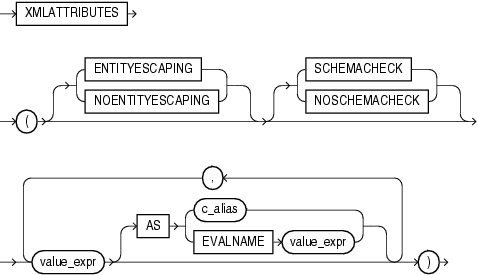| Oracle® Database SQL Language Reference 11g Release 2 (11.2) Part Number E17118-04 |
|
|
PDF · Mobi · ePub |
| Oracle® Database SQL Language Reference 11g Release 2 (11.2) Part Number E17118-04 |
|
|
PDF · Mobi · ePub |


XMLElement takes an element name for identifier or evaluates an element name for EVALNAME value_expr, an optional collection of attributes for the element, and arguments that make up the content of the element. It returns an instance of type XMLType. XMLElement is similar to SYS_XMLGen except that XMLElement can include attributes in the XML returned, but it does not accept formatting using the XMLFormat object.
The XMLElement function is typically nested to produce an XML document with a nested structure, as in the example in the following section.
For an explanation of the ENTITYESCAPING and NONENTITYESCAPING keywords, please refer to Oracle XML DB Developer's Guide.
You must specify a value for Oracle Database to use an the enclosing tag. You can do this by specifying identifier, which is a string literal, or by specifying EVALNAME value_expr. In the latter case, the value expression is evaluated and the result, which must be a string literal, is used as the identifier. The identifier can be up to 4000 characters and does not have to be a column name or column reference. It cannot be an expression or null.
The objects that make up the element content follow the XMLATTRIBUTES keyword. In the XML_attributes_clause, if the value_expr is null, then no attribute is created for that value expression. The type of value_expr cannot be an object type or collection. If you specify an alias for value_expr using the AS clause, then the c_alias or the evaluated value expression (EVALNAME value_expr) can be up to 4000 characters.
For the optional value_expr that follows the XML_attributes_clause in the diagram:
If value_expr is a scalar expression, then you can omit the AS clause, and Oracle uses the column name as the element name.
If value_expr is an object type or collection, then the AS clause is mandatory, and Oracle uses the specified c_alias as the enclosing tag.
If value_expr is null, then no element is created for that value expression.
See Also:
SYS_XMLGENThe following example produces an Emp element for a series of employees, with nested elements that provide the employee's name and hire date:
SELECT XMLELEMENT("Emp", XMLELEMENT("Name",
e.job_id||' '||e.last_name),
XMLELEMENT("Hiredate", e.hire_date)) as "Result"
FROM employees e WHERE employee_id > 200;
Result
-------------------------------------------------------------------
<Emp>
<Name>MK_MAN Hartstein</Name>
<Hiredate>2004-02-17</Hiredate>
</Emp>
<Emp>
<Name>MK_REP Fay</Name>
<Hiredate>2005-08-17</Hiredate>
</Emp>
<Emp>
<Name>HR_REP Mavris</Name>
<Hiredate>2002-06-07</Hiredate>
</Emp>
<Emp>
<Name>PR_REP Baer</Name>
<Hiredate>2002-06-07</Hiredate>
</Emp>
<Emp>
<Name>AC_MGR Higgins</Name>
<Hiredate>2002-06-07</Hiredate>
</Emp>
<Emp>
<Name>AC_ACCOUNT Gietz</Name>
<Hiredate>2002-06-07</Hiredate>
</Emp>
6 rows selected.
The following similar example uses the XMLElement function with the XML_attributes_clause to create nested XML elements with attribute values for the top-level element:
SELECT XMLELEMENT("Emp",
XMLATTRIBUTES(e.employee_id AS "ID", e.last_name),
XMLELEMENT("Dept", e.department_id),
XMLELEMENT("Salary", e.salary)) AS "Emp Element"
FROM employees e
WHERE e.employee_id = 206;
Emp Element
---------------------------------------------------------------
<Emp ID="206" LAST_NAME="Gietz">
<Dept>110</Dept>
<Salary>8300</Salary>
</Emp>
Notice that the AS identifier clause was not specified for the last_name column. As a result, the XML returned uses the column name last_name as the default.
Finally, the next example uses a subquery within the XML_attributes_clause to retrieve information from another table into the attributes of an element:
SELECT XMLELEMENT("Emp", XMLATTRIBUTES(e.employee_id, e.last_name),
XMLELEMENT("Dept", XMLATTRIBUTES(e.department_id,
(SELECT d.department_name FROM departments d
WHERE d.department_id = e.department_id) as "Dept_name")),
XMLELEMENT("salary", e.salary),
XMLELEMENT("Hiredate", e.hire_date)) AS "Emp Element"
FROM employees e
WHERE employee_id = 205;
Emp Element
-------------------------------------------------------------------
<Emp EMPLOYEE_ID="205" LAST_NAME="Higgins">
<Dept DEPARTMENT_ID="110" Dept_name="Accounting"/>
<salary>12008</salary>
<Hiredate>2002-06-07</Hiredate>
</Emp>